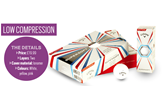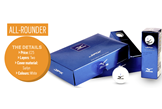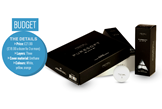Best sub £30 golf ball 2018
Published: Last updated:
Ten years ago, a box of £30 golf balls were perceived as lacking in performance compared to tour balls. Most were basic two-piece constructions with durable distance covers and zero short game feel.
But this market has completely reinvented itself. Now, £30 gets you everything from premium tour-level urethane cover balls to soft, low compression options as well as great all-rounders and some decent budget options, too.
Related: TaylorMade Tour Response vs. Titleist Pro V1
The trick to finding the best for your game is understanding how each helps your weaknesses, and realising there are new ways to buy balls on the internet. If you keep an open mind, you can get a seriously good ball to compliment your game, but also save some cash, too.
RELATED: Best Golf Balls of 2021
Here’s our 10 Top sub £30 balls of 2018…
Review: Callaway Super Soft golf ball

You need to know:
Callaway’s softest ball. The firm says softer balls give more forgiveness, as golfers see lower drop-offs in ball speed and less unwanted side and backspin. An ultra-low compression core promotes faster ball speeds and lower spin for longer and straighter full shots. An ionomer cover increases softness for great feel and wedge stopping spin.
We say:
The complete opposite of a “budget ball” from 10 years ago. As Callaway’s lowest compression ball the Super Soft really does give a very soft feel no matter what club you hit it with. Our pro felt at his club speed (with a driver) he probably compressed the ball too much to hit his longest drives, but the Super Soft was within two yards of his longest iron shots. Soft balls don’t necessarily mean more spin in the short game, but our data said 92% of the balls we tested were within 700rpm (backspin) of each other. That means they’re pretty difficult to separate for short game spin alone.
Verdict:
A brilliant low-compression ball. In our opinion the Super Soft is very well matched to golfers who own an average swing speed, which won’t over power and compress the ball too much to cost distance. That means most of us.
Review: Wilson DX3 Soft Spin golf ball

You need to know:
With a 40 compression Wilson says the DX3 is the world’s softest multi-layer ball. A new inner core generates lower-spinning drives for extra distance, while a softer surlyn cover increases spin on approaches. A new, shallower dimple design promotes higher trajectories and longer carry distances.
We say:
It wasn’t that long ago golf ball compression was a simple choice between 90 and 100, and back then the 40 compression Wilson would have been laughed at. Our test pro really enjoyed hitting the DX3, though like the low compression Callaway he gave up 3-4mph of ball speed with a driver, thanks to overpowering the structure of the ball. That certainly doesn’t mean it’s a bad choice, and at slower speed with irons the Wilson was within three yards of our pro’s longest and it span really nicely with a wedge.
Verdict:
Just like picking a driver or set of irons, our data shows that golf balls need careful selection, too. A brilliant low compression option for golfers who demand soft feel, even if you own a set of harder cast steel irons and wedges. The Wilson is very well suited to average driver swing speeds.
How different are Range and Premium balls?
Review: Vice Pro golf ball

You need to know:
Optimised for distance for advanced golfers who own a medium to high swing speed. Vice says it offers excellent green-grabbing control thanks to its S2TG tech cover, which includes urethane just like a premium tour ball.
We say:
What a revelation! We had no idea it was possible to create a ball for £29.98 a dozen that for many golfers would be indistinguishable from a leading tour ball. Our test pro loved the soft, sticky cover, and he said all-round feel and feedback with driver, iron and wedge was just like a tour ball. Wedge spin was within 500rpm of the highest on test, driver carry distance was just four yards back from the longest and ball speed was within 1mph of the quickest. And the Pro launched and flew higher than any ball on test. Seriously good.
Verdict:
Vice is an interesting model. Its balls are only available online, not in pro shops, which seriously reduces the price of the balls. If your ball of choice is currently a premium-priced tour favourite, we can only say the Vice Pro is every bit as comparable, for a lot less cash.
Review: Vice Pro Plus golf ball

You need to know:
Optimised for distance for good golfers with a medium to high swing speed. The Plus has a fourth layer which allows Vice to lower driver launch and spin for longer drives. All the same green-grabbing tech and good feel as the Pro.
We say:
Exactly the same premium sticky urethane cover as the Vice Pro, but with a firmer feel, which golfers who regularly play “X” balls will be accustomed to. Our test pro enjoyed the feel of the Plus more as he moved up through the bag, but for his personal preference it was a little firm in the short game. Our data shows the Plus launched 1.5° lower and peaked out three yards down on the Vice Pro, which should be a consideration if you’re a serious golfer working on lowering ball flight.
Verdict:
We agree with Vice – to get the best out of this ball you need either to have an above-average swing speed or harbour a particular desire to play a firmer ball and want to hit shots lower. Though a majority of tour players use firmer “x” balls, we’d say a huge majority of club golfers would be better served by the slightly softer Vice Pro.
Review: Srixon AD333 Tour golf ball

You need to know:
Designed for skilled golfers with moderate swing speeds who want the performance and feel of a tour ball. A lower compression lets golfers achieve optimal distance on full shots. A urethane cover and Spin Skin (like Srixon’s Z-Star) generates spin and control.
We say:
A tour ball that’s optimised for average swing speeds, and unlike some the AD333 Tour’s not gone chasing low compression at all costs. A 72 compression means the Tour feels firm enough with a driver and irons, but soft enough to offer excellent feedback within the short game and on the green. It’s no slouch when it comes to distance, either, recording a carry distance within five yards of the longest on test (the distance-orientated Titleist Velocity). Feels great off a wedge, though spin was a little down.
Verdict:
You won’t find much in golf that’s less expensive this year than last. Srixon, though, have dropped the Tour’s price by £4 a dozen for 2018. We’d say it’s a perfect ball for golfers who like the feel of a tour ball, but don’t quite own the swing speed needed to compress one fully. A lovely “normal” feel throughout the bag will win over golfers not sold on softer balls.
Review: Srixon AD333 golf ball

You need to know:
The UK’s best-selling two-piece ball. Srixon say while competitor ionomer balls offer similar distance on full shots as the AD333, their ball distinguishes itself with excellent greenside control, thanks to Spin Skin technology.
We say:
Over the last 15 years the AD333 has carved out a fond place among UK club golfers, and we can see why based on its solid across-the-board performance. A great ball for greedy golfers who insist on stacking everything in their favour. A driver ball speed within 2mph of the fastest on test means the AD333 is powerful; backspin was a little higher which robbed our test pro of a few yards, but wedge backspin was the second highest on test which is incredible for a two-piece golf ball. Our test pro said the AD333 offered an almost perfect blend of high energy from the tee and good backspin with the wedges, and all at a brilliant price.
Verdict:
A very well-rounded, reasonably priced golf ball that comes with an excellent pedigree for tons of normal golfers. Ideally positioned to perform for a wide range of swing speeds. The solid sound but soft feel is well suited to players who don’t want to join the march towards low-compression balls.
Review: Titleist Velocity golf ball

You need to know:
Powered for distance, says Titleist. A softer core and faster cover blend combine to generate extremely low spin and more distance. Expect a higher ball flight, which Titleist says means shots stop on the green. In Titleist’s words the Velocity offers “playable short game feel”.
We say:
The “powered for distance” tagline certainly rang true for our pro, as the Velocity was his longest carrying ball (280 yards), though it’s worth noting five other balls were within five yards. The Velocity was also our pro’s lowest-spinning ball with the driver, which to us says Titleist has pulled out all the stops to make it long. That said, peak height with the irons was just a yard down on the highest which would aid getting shots to stop on a green. Of all the balls tested the Velocity is closest to what golfers would consider a “traditional” distance ball; it didn’t compress nearly as much as some softer, lower compression options.
Verdict:
No doubt the Velocity is long. For us there’s a trade-off in feel for that speed and distance, but we reckon it suits a wide audience of swing speed golfers. Most at home in the hands of golfers wanting to rinse every last yard out of their game.
How different are Range and Premium balls?
Review: Mizuno JPX golf ball

You need to know:
Mizuno say two-piece ball tech has reached such a point that golfers now struggle to tell the difference between this and a tour ball. Optimised to deliver improved ball speeds for mid to low swing speed golfers, and a smooth feel.
We say:
We’ve done lots of testing with the JPX before, as four TG readers put the ball through its paces at the end of 2017. When you hear 10 and 11 handicappers say they can’t tell the difference between the JPX and their usual Pro V1 (which is more than twice the price) you take note. Our test pro was similarly impressed. The JPX posted an average carry just a yard shorter than the longest on test (with a driver), and backed it up by posting backspin numbers just a 100rpm (which is nothing) down on the highest spinning ball with a wedge.
Verdict:
For many the JPX would be an excellent choice of ball, irrespective of swing speed or feel preference. Incredibly it’s more than capable of holding its own in a scrap with premium tour balls in the hands of everyday club golfers… for £25 a dozen.
Review: TaylorMade Project (S) golf ball

You need to know:
Softer golf balls are slow without speed, say TaylorMade. The Project (s) focuses on lower driver spin and big distance. A Dual Core with large low-compression centre reduces driver spin. A softer, resilient polymer outer core, and compression 10 points (60 compression) lower than TaylorMade’s Project (a) ball improves feel.
We say:
The only ball in our test we had any difficulty categorising, bearing in mind TaylorMade already have optimised a ball for amateurs, the Project (a). While their design premise for the (s) was “soft with speed” we didn’t think feel was quite as soft as the low-compression Callaway or Wilson. As solid as the performance was with a driver, wedge and iron, it didn’t excel in any one area; it was good in all of them. A rock solid performance, which at this price should make the Project (s) a popular ball.
Verdict:
If you own a swing speed anywhere between just below average to just above, and don’t want a low compression or tour-style ball, the (s) will do a job for you. If your budget
doesn’t stretch to more than £25 a dozen, the (s) should be high on your shortlist of balls to try.
Review: Pearl Pure Soft golf ball

You need to know:
A soft urethane covered ball. The core’s size and compression are optimised to turn energy to ball speed while also feeling soft. A thin, fast mantle layer controls spin, and a soft durable cover offers great control on short game shots.
We say:
Pearl are a prime example of how the way golfers buy balls has changed. Like Vice you buy direct from their website, cutting out the middle man, which means Pearl offers a urethane covered ball for less than half the price of the market leader. Is it any good? Data shows wedge spin was within 500rpm of the best, driver carry distance was nine yards down on the longest (but more distance orientated) Titleist Velocity and five yards back from the comparable Vice Pro. Our pros numbers also had more variation (with bigger peaks and troughs between speed, spin and carry) than others.
Verdict:
If you can run to buying 3 dozen at a time the Pure Soft represents excellent value. We certainly aren’t saying you won’t be able to tell the difference between it and a tour ball. But for golfers who can’t justify £50 a dozen and want to stretch their cash to the limit, it should be on your golf ball radar.











